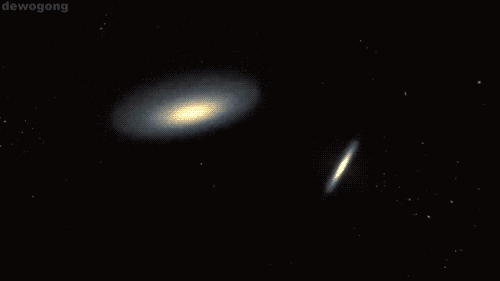It's The 1 Year Birthday For This Acct!!!
It's the 1 year birthday for this acct!!!
More Posts from Science-child and Others
Weird and Wonderful Irregular Galaxies
Spiral and elliptical galaxies seem neatly put together, but what happened to irregular galaxies? Irregular galaxies have one-of-a-kind shapes and many look like blobs! Why do they look the way they do? Astronomers think the uniqueness of these galaxies results from their interactions with other galaxies — like when they pass close to one another or even collide!

Looking back at the early universe with the help of our Hubble Space Telescope’s “deep field” observations, astronomers can peek at galaxies millions and billions of light-years away. They noticed that these far-away galaxies appear unusually messy, showing more star formation and mergers than galaxies closer to the Milky Way.

We also see irregular galaxies closer to home, though. Some may form when two galaxies pass close together in a near-miss. When this happens, their gravity pulls stars out of place in both galaxies, messing up the neat structure they originally had as spiral or elliptical galaxies. Think of it like this: you happen to have a pile of papers sitting at the edge of a table and when someone passes close by the papers become ruffled and may scatter everywhere! Even though the two galaxies never touched, gravity's effects leave them looking smeared or distorted.

Some irregular galaxies result from the collision between two galaxies. And while some of these look like a blob of stars and dust, others form dazzling ring galaxies! Scientists think these may be a product of collisions between small and large galaxies. These collisions cause ripples that disturb both galaxies, throwing dust, gas, and stars outward. When this happens, it pushes out a ring of material, causing gas clouds to collide and spark the birth of new stars. After just a few million years, stars larger than our Sun explode as supernovae, leaving neutron stars and black holes throughout the ring!

Not all galaxy collisions create irregular galaxies — our Milky Way spiral galaxy has gone through many mergers but has stayed intact! And for some interacting galaxies, being an irregular galaxy may just be a phase in their transformation. We’re observing them at a snapshot in time where things are messy, but they may eventually become neat and structured spirals and ellipticals.

Irregular galaxies are similar to each other, but unique and beautiful because of their different interactions, whether they’re just passing another galaxy or taking part in a dramatic collision. Keep up with NASA Universe on Facebook and Twitter where we post regularly about galaxies.
Make sure to follow us on Tumblr for your regular dose of space: http://nasa.tumblr.com.
Celebrating Spitzer, One of NASA’s Great Observatories
As the Spitzer Space Telescope’s 16-year mission ends, we’re celebrating the legacy of our infrared explorer. It was one of four Great Observatories – powerful telescopes also including Hubble, Chandra and Compton – designed to observe the cosmos in different parts of the electromagnetic spectrum.
Light our eyes can see
The part of the spectrum we can see is called, predictably, visible light. But that’s just a small segment of all the wavelengths of the spectrum. The Hubble Space Telescope observes primarily in the visible spectrum. Our Chandra X-ray Observatory is designed to detect (you guessed it) X-ray emissions from very hot regions of the universe, like exploded stars and matter around black holes. Our Compton Gamma Ray Observatory, retired in 2000, produced the first all-sky survey in gamma rays, the most energetic and penetrating form of light.

Then there’s infrared…
Infrared radiation, or infrared light, is another type of energy that we can’t see but can feel as heat. All objects in the universe emit some level of infrared radiation, whether they’re hot or cold. Spitzer used its infrared instrument to make discoveries in our solar system (including Saturn’s largest ring) all the way to the edge of the universe. From stars being born to planets beyond our solar system (like the seven Earth-size exoplanets around the star TRAPPIST-1), Spitzer’s science discoveries will continue to inspire the world for years to come.

Multiple wavelengths
Together, the work of the Great Observatories gave us a more complete view and understanding of our universe.

Hubble and Chandra will continue exploring our universe, and next year they’ll be joined by an even more powerful observatory … the James Webb Space Telescope!

Many of Spitzer’s breakthroughs will be studied more precisely with the Webb Space Telescope. Like Spitzer, Webb is specialized for infrared light. But with its giant gold-coated beryllium mirror and nine new technologies, Webb is about 1,000 times more powerful. The forthcoming telescope will be able to push Spitzer’s science findings to new frontiers, from identifying chemicals in exoplanet atmospheres to locating some of the first galaxies to form after the Big Bang.
We can’t wait for another explorer to join our space telescope superteam!
Make sure to follow us on Tumblr for your regular dose of space: http://nasa.tumblr.com
The Exploration Behind the Inspiration at NASA
Are we alone? How did we get here? Where are we headed?
At NASA, our mission is to explore. We visit destinations in our solar system and study worlds beyond to better understand these big questions.
We also dream. We dream of traveling to distant worlds, and what that might be like. In the video above you can see fanciful, imagined adventures to real places we’ve studied at NASA.
How We Did It
Check out how we created these otherworldly scenes in the video below. A NASA videographer used green screens to add motion and real people to bring life to our series of solar system and exoplanet travel posters.
Let’s dive into one example from the video. The shot of kayaking on Titan showcases the real rivers and lakes of liquid methane and ethane that slosh and flow on Saturn's largest moon. Titan's mysterious surface was revealed by our Cassini spacecraft, which also deployed the European Space Agency’s Huygens probe to the surface. The atmosphere on Titan is so thick, and the gravity so light, that with each strike of a paddle, you might be lofted above the swift current as you ride the tides through a narrow strait called the Throat of Kraken. NASA scientist Mike Malaska studies Titan and collaborated on the poster featured in the video. His research informed the artwork, and so did a hobby: kayaking. Those ultra-cold chemical seas might be even more of a challenge than shown here. Your boat might crack, or even dissolve, Malaska said.

We’ll learn more about Titan when our Dragonfly mission of dual quadcoptors — rotorcraft with eight blades each — visits the icy moon in 2034.
Science Never Stops
Our understanding of other worlds is always evolving, and sometimes we learn new details after we illustrate our science. In one of our travel posters, we show a traveler standing on the surface of exoplanet Kepler-16b with two shadows formed by the planet’s two suns. The planet does indeed orbit two stars, but with later size and mass refinements, we now think it would be hard to stand there and enjoy a binary sunset. There isn't a solid surface to stand on a gas planet, and that's what Kepler-16b now appears to be!
In addition to sharing how sublime science can be, these scenes are a reminder that there are lots of careers in the space program, not just scientist, engineer, or astronaut. A creative team at NASA’s Jet Propulsion Laboratory in Southern California produced the travel posters, originally to help share the work of NASA's Exoplanet Exploration Program. They are the result of lots of brainstorming and discussion with real NASA scientists, engineers, and expert communicators. The video versions of these spacey travel scenes were produced by visualization experts at NASA’s Goddard Space Flight Center in Greenbelt, Maryland.
All of this work is meant to inspire, and to explore the edge of possibility. It’s also an invitation. With science, we’re stepping into the future. Join us?
what is the biggest challenge in the preparation of such a mission and how do you handle it?
"I do not know how I may appear to the world, but to myself I seem to have been only like a boy, playing on the sea-shore, and diverting myself, in now and then finding a smoother pebble or prettier shell than ordinary, whilst the great ocean of truth lay all undiscovered before me."
-Isaac Newton-





